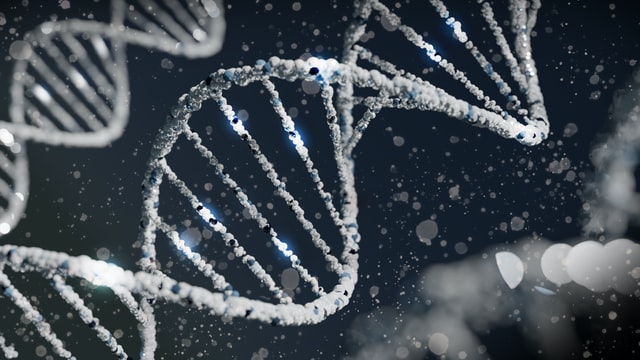All our hereditary characteristics are deposited in the DNA contained in each individual cell, which is condensed into 23 pairs of chromosomes, in which each pair is constituted by a chromosome of maternal material and another of paternal material. Each of us therefore simultaneously contains part of our father’s genetic make-up and part of our mother’s.
The chromosomes contain genes and it is estimated that DNA
contains approximately 25,000 genes.  A gene is the smallest physical unit that transmits information from one generation to the next and it occupies a fixed position (locus) in a particular chromosome. Each gene has a specific function, such as producing a given protein for cardiac cells, therefore an alteration (mutation) in a gene causes a sub-optimal functional result. This alteration that is primarily genetic (of the gene) and consequently functional (protein produced in amounts that differ from those produced by a normal gene) can lead to the onset of diseases that are therefore known as genetic diseases.
A gene is the smallest physical unit that transmits information from one generation to the next and it occupies a fixed position (locus) in a particular chromosome. Each gene has a specific function, such as producing a given protein for cardiac cells, therefore an alteration (mutation) in a gene causes a sub-optimal functional result. This alteration that is primarily genetic (of the gene) and consequently functional (protein produced in amounts that differ from those produced by a normal gene) can lead to the onset of diseases that are therefore known as genetic diseases.
The molecular genetics of arrhythmogenic right ventricular cardiomyopathy
Arrhythmogenic right ventricular cardiomyopathy (ARVC) is an autosomal dominant genetic disease with incomplete penetrance: each person who is a carrier of a mutation has a 50% likelihood of transmitting the mutation to his/her offspring; however, as the disease has incomplete penetrance, not all individuals with the mutation develop the disease.
So far, 14 genes have been identified as being involved in the genetic determination of the disease, of which 5 were identified by the Padua University research group.
Of the 13 genes known to date, 9 encode for proteins that are involved in the formation of cell junctions known as intercalated discs, constituted by mechanical junctions such as desmosomes and the area composita and by gap junctions, which produce a direct connection between two adjacent cells (see figure and table). The names of these 9 proteins are: Desmoplakin (DSP), Desmoglein-2 (DSG2), Desmocollin-2 (DSC2), Plakophilin, Plakoglobin, alpha-T-catenin (CTNNA3), N-cadherin (CDH2), Luma (TMEM43), and Desmin (DES).
The other genes encode proteins with other functions and are: Cardiac ryanodine receptor (RYR2), Transforming growth factor-beta3 (TGF-beta3), Titin (TTN) and Phospholamban (PLN). RYR2 gene mutations are involved in the onset of catecholaminergic polymorphic ventricular tachycardia (CPVT).
According to the data published in literature, the genes that are most frequently involved are Desmoplakin, Plakophilin-2 and Desmoglein-2, known as the “Big 3”, and which account for approximately 80-85% of the mutations in patients. Approximately 13% of patients are carriers of one or more mutations in the same gene or different genes. It is therefore important to perform the mutation tests on the DNA of a patient for all the genes known to date. In patients in whom one or more mutations have been identified it is possible to extend the analysis to all the available relatives in order to identify the carriers of the mutation.
In approximately 40% of cases, none of the gene mutations currently known is identified, which suggests that other genes that have yet to be identified are also involved in arrhythmogenic cardiomyopathy.
FIGURE:
Schematic representation of the mechanical junctions of the intercalated discs of heart muscle (Adapted from Calore et al., 2014)

GENES CURRENTLY IDENTIFIED AS BEING RESPONSIBLE FOR ARRHYTHMOGENIC RIGHT VETRICULAR CARDIOMYOPATHY
| ARVD | GENE | NAME AND FUNCTION | MUTATION FREQUENCY | REFERENCES |
|---|---|---|---|---|
| ARVD1 | TGFb3 | Transforming growth factor beta 3 (involved in the production of fibrosis) | Rare | Beffagna et al., 2005 |
| ARVD2 | RYR2 | Cardiac ryanodine receptor (cardiac calcium release channel) | Rare | Tiso et al., 2001; Bauce et al., 2002 |
| ARVD5 | TMEM43 | Transmembrane protein 43/ LUMA (nuclear membrane protein) | Rare | Merner et al., 2008 |
| ARVD8 | DSP | Desmoplakin (cell junction protein) | 1-16% | Rampazzo et al., 2002; Bauce et al., 2005 |
| ARVD9 | PKP2 | Plakophilin (cell junction protein) | 10-45% | Gerull et al., 2004 |
| ARVD10 | DSG2 | Desmogleina 2 (proteina delle giunzioni cellulari) | 7-12% | Pilichou et al., 2006 |
|
ARVD12 NAXOS
|
JUP | Placofilina (proteina delle giunzioni cellulari) | 1% | McKoy et al., 2000 |
| ARVD13 | DES | Desmina (proteina del citoscheletro) | Rare | Klauke et al., 2010 |
| ARVD14 | TTN | Titina (proteina del sarcomero) | Rare | Taylor et al., 2011 |
| DSC2 | Desmocollina-2 | 1-5% | Syrris et al., 2006 | |
| CTNNA3 | Alfa-T-catenina | 2% | Van Hengel et al., 2013 | |
| CDH2 | N-caderina | Rare | Mayosi et al., 2017 | |
| PLN | Fosfolambano | Rare | Van der Zwaag et al., 2012 |
Professor of Applied Biology
Department of Biology, University of Padua


